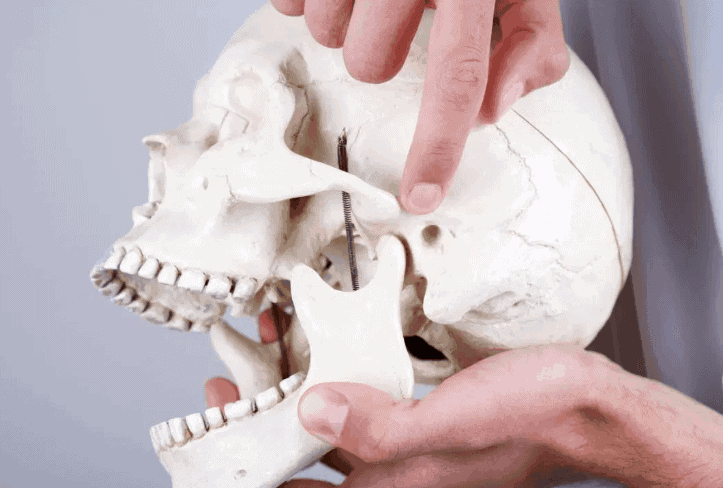Every day, we received many emails from our readers. And today, I would like to share with you one of the stories from Robert in Ohio. He has sent an email to Linkingo, sharing his TMJ story and how to treat TMJ.
Robert started suffering from jaw pain and discomfort during his early 20s. After going to the dentist, he was suggested to wear a nociceptive trigeminal inhibition splint (NTI), small bite guards put between the front teeth.

Since NTI bite guards helped him relieve his jaw pain, he continued wearing it for two years. After that, the conditions got worse, and the bite guards were not helping anymore. He was suffering these symptoms:
- Difficult to open mouth wide
- Pain when chewing
- Gum inflammation
- Headaches
- Ear popping and ringing
- Pain in the neck and shoulder
He paid a visit to his dentist again, and as expected, he is diagnosed with Temporomandibular joint (TMJ) disorder. At the time, the dentist said his only available option was surgery. Robert was really panicked when receiving the bad news. However, he decided to remain calm, endure his pain, went home, did a little research about his disease and explored for more options.
Understanding the possible sources of TMJ
The TMJ joint is located at the base of your skull, which allows the movement for functions such as chewing and talking. The joint is one of the most complicated joints in the body that connects the lower jaw and the temporal bone. It allows up and down, side to side movements.

TMJ disorders affect the TMJ joint, causing constant pain, discomfort, and restricted jaw movements. There are many possible causes for TMJ:
-
- A disorder in the articular disc: The articular disc is located between the jawbone and skull that keeps jaw movements running smoothly.
- Arthritis or inflammation: Arthritis can damage the cartilage in the TMJ.
- Physical injury to the jaw area: Even minor jaw injury can cause TMJ disorder.
- Sleep disorder breathing: This happens when your airway collapses while sleeping and blocks your breathing. Your body instinct is to force your lower jaw to open up the airway. This creates tension that exhausts your jaw muscles.
- Teeth grinding and clenching while sleeping: This creates tension in the jaw muscles, leading to TMJ disorder.
- Dental procedures: Surgery like removal of wisdom teeth can increase your risk of having TMJ disorder since your jaw is overextended.
- Dental problems such as malocclusion: It is an improper alignment between the lower and upper teeth. The fit of the teeth modifies the lower jaw position, affecting the surrounding muscles.
Other known possible causes may be genetic, hormonal, or environmental that can increase the risk of TMJ disorder. For example, frequent gum chewing or constant jaw positions, such as using the shoulder to hold a phone, may also lead to TMJ. Violinists may also have a higher risk of experiencing TMJ disorder since it involves jaw stretching or positioning their neck and head to hold their instrument.
According to the TMJ Association, female sex hormones, particularly estrogen, is a possible cause of TMJ disorder since jaw problems are more commonly found in women during their pregnancy.
Major TMJ Disorder Symptoms
Pain
Jaw pain is the most obvious symptom of TMJ disorder. Jaw muscles are very powerful. If your jaw is not in the proper position, the muscles try to improve the problem by pulling your jawbones into proper position. The common result is teeth grinding and clenching. Eventually, your muscles exhaust, leading to tension and pain.
Other pain symptoms may include neck and shoulder pain, headaches or migraines, pain around the ear and cheek.
Noises
Another common symptom is unusual noises such as popping, clicking, grating sounds while eating, talking, and opening your mouth.
Noise when moving your jaw is quite common and not necessarily related to TMJ disorder. It is only when it comes along with pain or limited jaw movements that medical consultation may be needed. Ringing, buzzing, or numbness in the ears, together with ear pain, are the symptoms that need to be considered as TMJ disorder symptoms.
Limited jaw movements
When suffering from TMJ disorder, patients find it hard to fully open their mouth or move the jaw in certain directions. Such limitation may be the result of muscle strain that prevents your mouth from opening to a normal distance. This can cause great irritation in everyday life.
Locking of the jaw
Catching or locking may occur at the time of opening or closing. This happens when the jaw joint is out of line, and the mandible can become moved out of the shallow cavity, then the jaw is locked. In this case, the jaw joint misalignment can lead to inflammation and pain.
Treatment Options For TMJ
For TMJ treatments, there are some options such as medications, oral splints or mouth guards, and physical therapy.
Drugs, medicines such as pain relievers, muscle relaxers, and anti-inflammatory drugs are usually given to TMJ patients to alleviate pain.
After that, the next objective is to keep your jaw in place by using soft or hard oral devices. Massages and stretches are also helpful in strengthening your jaw.
The last option when other treatments cannot relieve your pain is surgery or other procedures.
Some of these might include open joint surgery, injections, arthroscopy, or condylotomy.
Depending on the severity, treatment costs can widely vary from $5,000 for orthotics up to $50,000 for a full mouth reconstruction.
Read More: The Best 5 Home Remedies for TMJ you must try
The Innovative Approach To Treat TMJ permanently
After intensive research to understand more about TMJ disorder, Robert continued to explore his options on how to treat TMJ besides the current treatments that his doctor offered him. He came across the program called “TMJ No More” created by Christian Goodman that can treat TMJ permanently with a cost of less than one meal.
Robert is quite concerned about this program as it might be just a scam and wastes his time. His TMJ conditions are getting worse; hence, he cannot afford to lose his time and money on some myths. However, he has read many successful stories from real TMJ patients. Their experience is exciting, with amazing results. He is really excited yet worried whether this could really be his final answer to how to treat TMJ once and for all.
Robert has followed Linkingo for a long time, and he knew that the Linkingo team specializes in researching and reviewing different health products. He believes that Linkingo can give him the most comprehensive and informative review of this product. Hence, he has sent a request to our team to do a review of this TMJ treatment.
After receiving his request, I have spent 4 hours investigating this program. You can find my complete TMJ No More review here. This is one of my proudest works, and I hope you find it useful as Robert did. After reading my review, he has full trust in the program and decided to give it a try. He has currently been in 1-week of the program and he has never felt better. His TMJ symptoms disappeared, and most importantly, he doesn’t need to go through any surgery.
To be honest, when I first heard about TMJ No More, I was a bit suspicious since it is a completely different treatment. How could a program with no drugs, medications, and equipment be useful? However, I was wrong, and now I have full confidence in the program.
TMJ is an innovative and revolutionary approach to treat TMJ disorder. It is 100% natural and safe treatment as it consists of only simple and easy exercises. These exercises are designed to specifically focus on your jaw, facial, neck, and shoulder to relieve the tension and strain.
More importantly, TMJ No More not only focuses on alleviating your TMJ symptoms, but it also incorporates relaxation, attitude, and communication exercises. Since TMJ sufferers deal with anger, mood swings, and discomfort caused by physical pain, TMJ No More takes into consideration of mental health perspective. The objective is to relax patients’ minds, lower stress levels, and negative emotions.

>>> Read the full TMJ No More Review Here
Finally
TMJ disorder is a common disease that should be taken seriously. It only affects your jaw but also other areas of your body such as the face, ear, neck, and shoulder, causing severe symptoms if left unattended. Although there are many available treatments for TMJ, they can only alleviate the symptoms, not completely get rid of TMJ. Since there is the involvement of drugs, medications, and surgery, there are dangerous side effects in these solutions too. If you are looking for a remedy for how to treat TMJ completely that is safe and effective, I really believe that TMJ No More is the best solution for you. It not only helps you relieve physical pain but also relaxes your mind and improves your overall life quality.
Thank you for your time. Please support me with likes and shares for this article. As usual, feel free to leave your questions and comments below.
Related articles:
- TMJ No More Review: Does Christian Goodman’s Program Work?
- The Best 5 Home Remedies for TMJ you must try
- How To Cure TMJ Permanently – 100% Safe And Natural






Leave a Reply